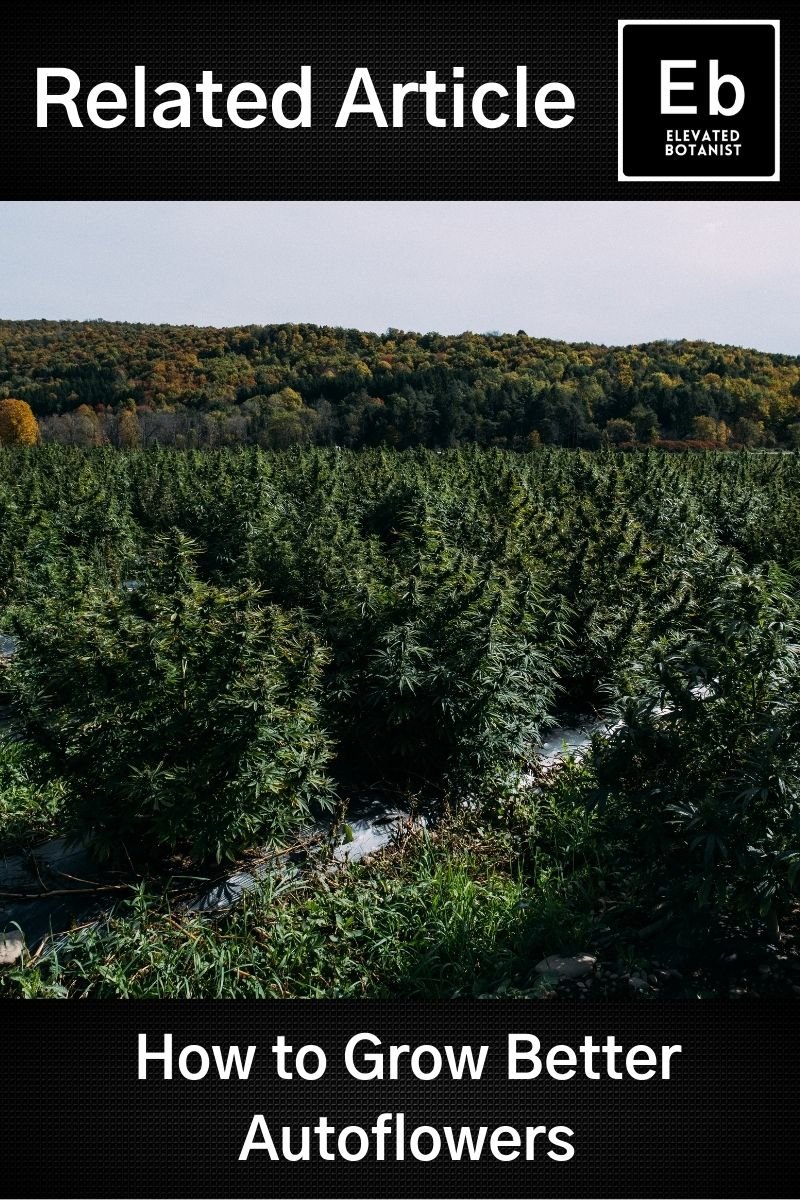Buying Cannabis Seeds - 10 things you need to know
Weed seeds are expensive, and most of us only get to grow a few each year. Starting your grow with great genetics is the first step in cultivating quality cannabis.
This article will answer your burning questions and provide you with unbiased information so you can buy weed seeds that meet your HIGH expectations.
There are no ads, affiliate links, or conflicts of interest in this article.
Elevated Botanist is not for sale.
The 10 things to know when buying Weed Seeds:
Legal Weed Seeds
Seed Banks
Seed Packaging
Feminized Seeds
Hermie Plants
Photoperiod Strains
Autoflower Strains
Fast Strains
Sativa or Indica?
Hybrid Strains
Legal Weed Seeds
You need to do your homework to ensure that purchasing cannabis seeds is legal in your area. Cannabis seeds do not contain THC and are often sold legally as a “novelty” even in places where personal growing is not permitted.
The DEA recently clarified that cannabis seeds are not a controlled substance, and can be traded legally, but many states have their own laws regarding weed seeds.
Cannabis seeds will often be confiscated if they are found by mail carriers.
Seed Banks
Established seed banks, operating in places where their business is legal, are the most reliable sources for quality cannabis seeds. Reputable seed banks sell seeds from many different breeders in original packaging, accept payment in multiple formats, fill orders immediately, and provide postal tracking on request.
There are lots of players out there with weed seeds for sale so if you buy from Bob on the internet, it’s buyer beware.
We don’t want to name drop here (sorry Bob), but you should check out reviews before purchasing from any cannabis seed bank.
Sometimes you can purchase seeds directly from breeders, or they can recommend a seed bank that sells their strains.
Seed Packaging
Weed seeds are usually shipped in original breeder packaging to ensure authenticity.
Packaging should be crush proof, contain important information about the strain, and often includes a desiccant bead to protect seeds from humidity. Most seed banks will ship seeds to you in discreet packaging on request.
Reputable breeders do not supply bulk cannabis seeds to seed banks for repackaging and distribution.
When a breeder’s reputation is at stake, they want to ensure that you are receiving fresh seeds that have been properly packaged for longevity.
“Seed Banks” that sell hundreds of varieties under their own brand are usually just copying the hard work of others and slapping a cool name on the package.
The price of seeds is similar whether you buy them from the bank or from Pirate Bob, so it is worth it to find a reputable seed bank and only buy seeds in original breeder packaging.
Seeds are usually shipped as packages by priority mail. Mail sorting machines roll envelopes during handling which will crush any seeds inside.
If you want to mail seeds and save on postage, you can use a hose washer and a coin flip to make a crush proof seed package. Ten seeds or so can be safely mailed in a standard envelope.
Feminized Seeds
Feminized seeds have been bred to produce only female plants, where regular seeds usually produce about 50% male and 50% female plants. This process doesn’t change the seed DNA in any way but ensures that all seeds have two X chromosomes.
Female plants are desirable for production of fragrant flowers, and males are usually culled to avoid seeding. It can take 6-8 weeks of growth before it is possible to visually identify male from female plants.
If you are only growing a few plants at a time, you want to be sure that they are all female from the very beginning.
Feminized seeds are made by treating a female plant with a chemical that disrupts the hormone signaling system. This causes the female plant to make male flowers and pollen. When this feminized pollen is used to pollinate another female plant, all the seeds produced are female.
Hermie Plants
Cannabis plants are normally dioecious, and male and female flowers occur on separate plants.
In some cases, male flower parts can form on female plants and potentially seed your crop.
Quality weed seeds will produce 2-4 hermies per thousand, but the ratios can be much higher in some strains.
Early detection of hermie (intersex) plants is necessary to remove them from your garden before pollen is released.
You can eliminate hermies from your garden by learning how to identify the first signs of male preflowers on your cannabis plants.
The best way to avoid hermies is to buy your weed seeds from reputable seed breeders who stress tests their genetics to avoid using intersex plants in their breeding programs.
Most home growers will never experience an intersex plant if they buy quality feminized seeds and avoid the hype strains that are commonly made from untested “elite” clones.
Photoperiod Strains
Photoperiod cannabis plants are short-day plants, meaning that they will not start flowering until they experience short days and long nights. Photoperiod strains usually require day lengths of no longer that 13-14 hours to initiate flowering once they have reached maturity.
If you are growing outdoors, it is important to know the critical photoperiod of your strain, and the seasonal daylength in your area to determine what time of season you will be harvesting. Early to mid-May is usually the best time to plant seeds outdoors in the Northern Hemisphere.
If you are growing indoors, you can control the photoperiod, and most growers will set 18-hour days for vegetative growth and reduce the light to 12 hours when the plants are large enough for flowering.
Short-day plants are usually the best choice for indoor growers who can keep clones of their favorite plants for year-round production.
Autoflower Strains
Autoflowering cannabis strains are Day-Neutral and will begin flowering automatically about three to four weeks after they are planted regardless of the photoperiod.
Autoflowers have a short grow cycle and can be harvested between 70 and 100 days after germination.
Because of this feature, autoflowering strains are often the best choice for an outdoor or patio garden.
Knowing how many days are required from sowing seeds to harvesting weed allows outdoor growers to harvest at the best time of the season.
Autos have come a long way in the past few years. Autoflower breeders regularly release new strains that produce weed that is over 20% THC with great terpene profiles.
Autos tend to be a bit smaller than full season plants and can be tricky to grow because they have a short lifecycle, and don’t have much time to recover from grower error.
Fast Strains
Cannabis strains that will begin flowering during 14-16 hour days are sometimes referred to as photoperiod sensitive, or Fast strains.
These strains can be created by cross breeding photoperiod and autoflowering strains.
Fast strains will often begin flowering if they become root bound, or if they are planted outside too early in the season.
For northern growers (above 40 degrees latitude) fast strains will often begin flowering in July for harvest in September before growing conditions deteriorate.
Fast strains have a much higher yield potential than autoflower strains, and clones of exceptional plants can be kept and cultivated year after year.
Some of the best Fast, and Autoflowering strains on the market right now are being made by breeders based in Spain.
Sativa or Indica?
Sativa and Indica were previously considered separate species, but most botanists now agree that cannabis is one species. The term Indica is commonly used to describe strains with a more sedative effect, while Sativa is more motivational.
Get the Outdoor Grow Guide Here
Regardless of what you call your plant, you should make sure that the strain that you want to grow is suitable for your grow conditions as well as for your medical conditions.
Many breeders will advertise their strains as Sativa Dominant, or Indica Dominant.
Plants that are referred to as Sativa dominant tend to have narrower leaf blades and longer internodes, while Indica dominant strains are shorter, with wider leaf blades.
Many Indica strains are related to Afghanica plants that evolved in dry climates, and don’t have great mold resistance.
Outdoor growers will benefit from sourcing seeds that have been bred outside, as these strains are more likely to display resistance to some of the pests present in outdoor growing environments.
Seed breeders that focus on outdoor growing can usually provide accurate estimates of the harvest date of their strains at your latitude.
Hybrid Strains
Most cannabis strains are hybrids, meaning that they contain a mix of genetics from different parts of the world. This can be a good thing, as hybrid weed plants typically benefit from hybrid vigor, and will outgrow inbred cannabis strains.
The best seeds for most growers are referred to as F1 hybrids. This means that the seed is the result of the first generation of crossbreeding between two unrelated strains. F1 hybrids will typically exhibit hybrid vigor, while keeping some phenotypic consistency between seeds.
I hope this helps you source the best seeds for your cannabis grow. Please check out my outdoor grow guide below for more info to help you get the best result on your next grow. Cheers!
-
You need to do your homework to ensure that purchasing cannabis seeds is legal in your area.
Cannabis seeds do not contain THC and are often sold legally as a “novelty” even in places where personal growing is not permitted.
-
Established seed banks, operating in places where their business is legal, are the most reliable sources for quality cannabis seeds.
Reputable seed banks sell seeds from many different breeders in original packaging, accept payment in multiple formats, fill orders immediately, and provide postal tracking on request.
-
Weed seeds are usually shipped in original breeder packaging to ensure authenticity.
Packaging should be crush proof, contain important information about the strain, and often includes a desiccant bead to protect seeds from humidity.
Most seed banks will ship seeds to you in discreet packaging on request.
-
Feminized seeds have been bred to produce only female plants, where regular seeds usually produce about 50% male and 50% female plants.
This process doesn’t change the seed DNA in any way but ensures that all seeds have two X chromosomes.
-
Cannabis plants are normally dioecious, and male and female flowers occur on separate plants.
In some cases, male flower parts can form on female plants and potentially seed your crop.
Quality weed seeds will produce 2-4 hermies per thousand, but the ratios can be much higher in some strains.
-
Photoperiod cannabis plants are short-day plants, meaning that they will not start flowering until they experience short days and long nights.
Photoperiod strains usually require day lengths of no longer that 13-14 hours to initiate flowering once they have reached maturity.
-
Autoflowering cannabis strains are Day-Neutral and will begin flowering automatically about three to four weeks after they are planted regardless of the photoperiod.
Autoflowers have a short grow cycle and can be harvested between 70 and 100 days after germination.
-
Cannabis strains that will begin flowering during 14-16 hour days are sometimes referred to as photoperiod sensitive, or Fast strains.
These strains can be created by cross breeding photoperiod and autoflowering strains.
-
Sativa and Indica were previously considered separate species, but most botanists now agree that cannabis is one species.
The term Indica is commonly used to describe strains with a more sedative effect, while Sativa is more motivational.
-
Most cannabis strains are hybrids, meaning that they contain a mix of genetics from different parts of the world.
This can be a good thing, as hybrid weed plants typically benefit from hybrid vigor, and will outgrow inbred cannabis strains.







